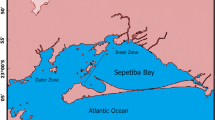Abstract
The dietary composition of juvenile Trematomus newnesi, trawled at Potter Cove, South Shetland Islands, in the summers 2004–2005 and 2005–2006 was analysed using frequency of occurrence (F%) and dietary coefficient Q (%) methods. The samples consisted exclusively of immature specimens in the range 4–15.4 cm (total length) and are complementary to those of larger fish from the same site, including adults, which were analysed in previous work. Benthic-demersal organisms such as gammaridean amphipods and harpacticoid copepods were the main (coefficient Q) and most frequent (F%) prey. The importance of the smaller and larger main prey diminished and increased, respectively, during ontogeny. Pelagic krill, being negligible in the diet of the small and medium size fish categories, became secondary food, but only for fish larger than 12 cm. Other taxonomic groups occurred scarcely and constituted occasional food. They were mostly benthic, such as gastropods, bivalves, isopods, cumaceans, and algae, with the exception of an insignificant number of pelagic ostracods and calanoid copepods. Unlike the more pelagic/planktivorous mode of life known for late juvenile-adult stages of T. newnesi, including cryopelagy, present results indicate that early juvenile fish remain sheltered among macroalgae beds preying on the associated community of demersal-benthic organisms.





Similar content being viewed by others
References
Andriashev AP (1970) Cryopelagic fishes of the Arctic and Antarctic and their significance in polar ecosystems. In: Holdgate MW (ed) Antarctic ecology, vol 1. Academic, London, pp. 297–304
Barrera-Oro ER (2002) The role of fish in the Antarctic marine food web: differences between inshore and offshore waters in the southern Scotia Arc and west Antarctic Peninsula. Antarct Sci 14:293–309
Barrera-Oro ER, Casaux RJ (1990) Feeding selectivity in Notothenia neglecta, Nybelin, from Potter Cove, South Shetland Islands, Antarctica. Antarct Sci 2:207–213
Barrera-Oro ER, Casaux RJ (1998) Ecology of demersal fish species from Potter Cove. In: Wiencke C, Ferreyra GA, Arntz W, Rinaldi C (eds) The Potter Cove coastal ecosystem, Antarctica. Ber Polarforsch 299:156–167
Barrera-Oro ER, Casaux RJ, Marschoff E (1998) Analysis of the diet of Champsocephalus gunnari at South Georgia in late summer from 1994 to 1997, Dr. Eduardo L. Holmberg surveys. CCAMLR Sci 5:103–123
Casaux RJ, Mazzotta AS, Barrera-Oro ER (1990) Seasonal aspects of the biology and diet of nearshore nototheniid fish at Potter Cove, South Shetland Islands, Antarctica. Polar Biol 11:63–72
Casaux RJ, Barrera-Oro ER, Baroni A, Ramón A (2003) Ecology of inshore notothenioid fish from the Danco Coast, Antarctic Peninsula. Polar Biol 26:157–165
Daniels RA (1982) Feeding ecology of some fishes of the Antarctic Peninsula. Fish Bull 80:575–588
Eastman JT, DeVries AL (1982) Buoyancy studies of notothenioid fishes in McMurdo Sound, Antarctica. Copeia 2:385–393
Eastman JT, DeVries AL (1997) Biology and phenotypic plasticity of the Antarctic notothenid fish Trematomus newnesi in McMurdo Sound. Antarct Sci 9:27–35
Fanta E, Meyer AA, Grötzner SR, Luvizotto MF (1994) Comparative study on feeding strategy and activity patterns of two Antarctic fish: Trematomus newnesi Boulenger, 1902 and Gobionotothen gibberifrons (Lönnberg, 1905) (Pisces, Nototheniidae) under different light conditions. Antarct Rec 38:13–29
Gon O, Heemstra PC (eds) (1990). Fishes of the Southern Ocean. Grahamstown, South Africa: J.L.B. Smith Institute of Ichthyology, 462 pp
Hureau JC (1970) Biologie comparée de quelques Poissons antarctiques (Nototheniidae). Bull Inst Océanogr Monaco 68:1–244
Kock KH, Kellermann A (1991) Reproduction in Antarctic notothenioid fish: a review. Antarct Sci 3:125–150
La Mesa M, Vacchi M, Zunini Sertorio T (2000) Feeding plasticity of Trematomus newnesi (Pisces, Nototheniidae) in Terra Nova Bay, Ross Sea, in relation to environmental conditions. Polar Biol 23:38–45
Linkowski TB, Presler P, Zukowski C (1983) Food habits of nototheniid fishes (Nototheniidae) in Admiralty Bay (King George Island, South Shetland Islands). Pol Polar Res 4:79–95
Moreno CA, Zamorano JH (1980) Selección de los alimentos en Notothenia coriiceps neglecta del cinturón de macroalgas de Bahía South, Antártica. Ser Cient Inst Antárt Chil 25/26:33–44
Moreno CA, Zamorano JH, Duarte WE, Jara HF (1982) Abundance of Antarctic juvenile fishes on soft-bottom substrates: the importance of the refuge. Cybium 6:37–41
Rakusa-Suszczewski S, Piasek A (1973) Size, feeding and action of proteolytic enzymes in the Antarctic fish of the Trematomus genus (Notothenidae). Bull Pol Acad Sci Biol Sci Ser 21:139–144
Richardson M (1975) The dietary composition of some Antarctic fish. Br Antarct Surv Bull 41:113–120
Takahashi M, Iwami T (1997) The summer diet of demersal fish at the South Shetland Islands. Antarct Sci 9:407–413
Targett TE (1981) Trophic ecology and structure of coastal Antarctic fish communities. Mar Ecol Prog Ser 4:243–263
Tiedtke JE, Kock KH (1989) Structure and composition of the fish fauna around Elephant Island. Archiv für Fischereiwissenschaft 39:143–169
Vacchi M, La Mesa M (1995) The diet of the Antarctic fish Trematomus newnesi Boulenger, 1902 (Notothenidae) from Terra Nova Bay, Ross Sea. Antarct Sci 7:37–38
Williams R (1988) The inshore marine fishes of Vestfold Hills region, Antarctica. Hydrobiologia 165:161–167
Zukowski C (1980) Catches of fishes of the genus Notothenia and Trematomus at Admiralty Bay (King George Island, South Shetland Islands) in the winter-spring season, 1977. Pol Polar Res 1:163–167
Acknowledgments
We thank Carlos Bellisio, Luis Vila and Oscar Gonzalez for their help in the field activities. We are very grateful to Drs. G. Alonso and F. Momo for the identification of the amphipods and to Lic. E. Dinofrio for the identification of the calanoid copepods. The manuscript was kindly reviewed by Prof. J. Eastman and Dr. J. Montgomery.
Author information
Authors and Affiliations
Corresponding author
Rights and permissions
About this article
Cite this article
Barrera-Oro, E.R., Piacentino, G.L.M. Feeding habits of juvenile Trematomus newnesi (Pisces, Nototheniidae) at Potter Cove, South Shetland Islands, Antarctica. Polar Biol 30, 789–796 (2007). https://doi.org/10.1007/s00300-006-0238-y
Received:
Revised:
Accepted:
Published:
Issue Date:
DOI: https://doi.org/10.1007/s00300-006-0238-y




